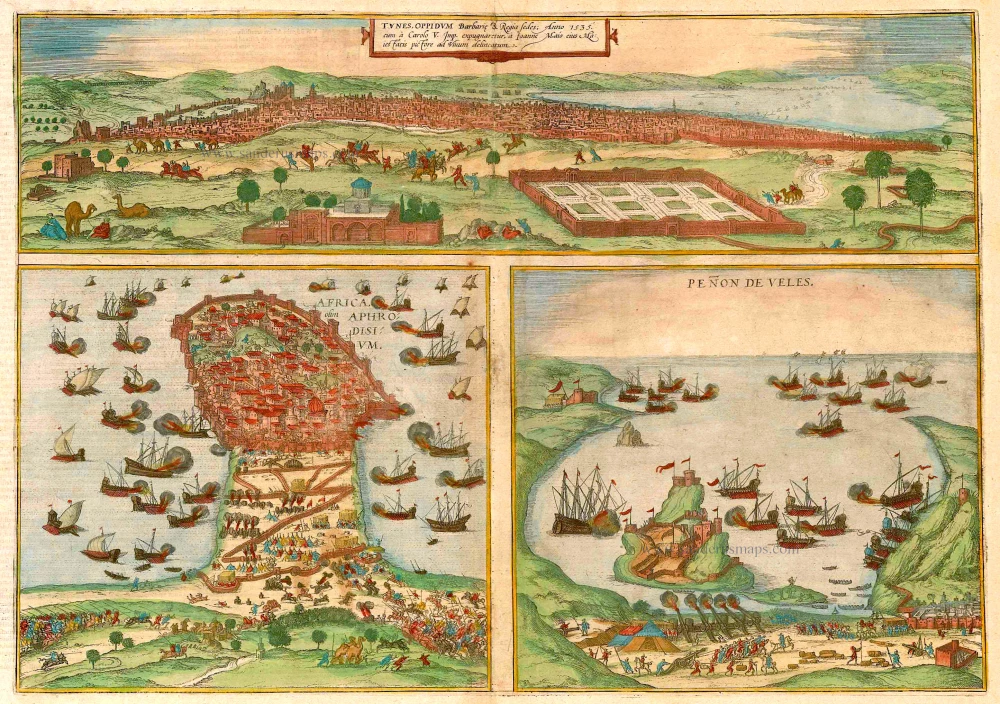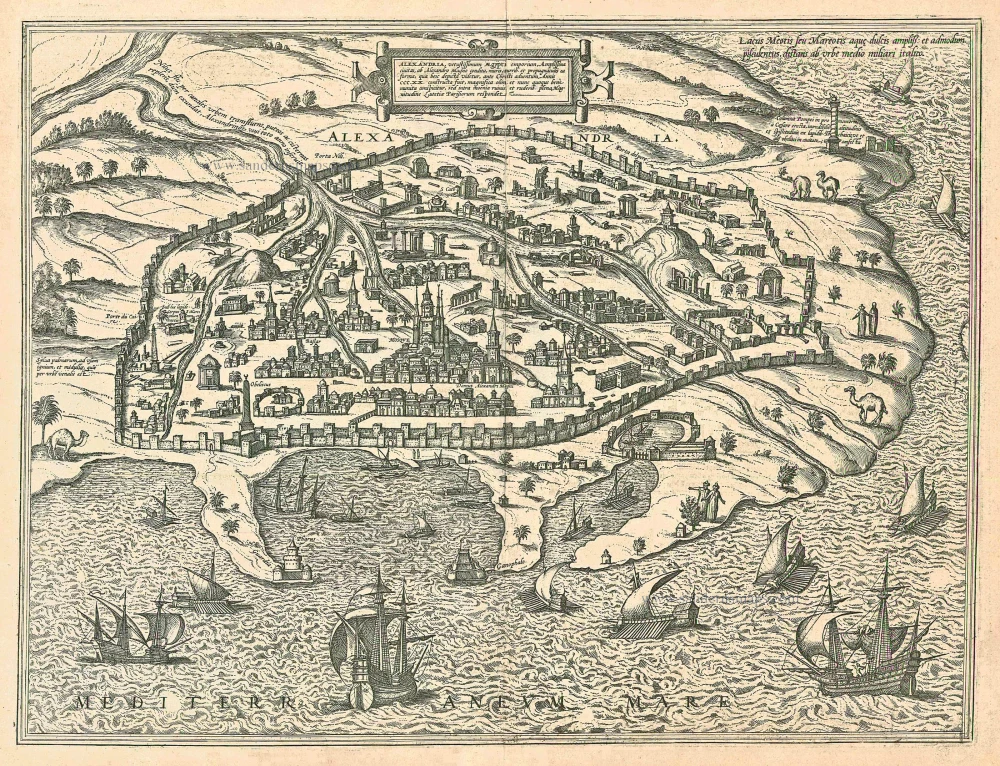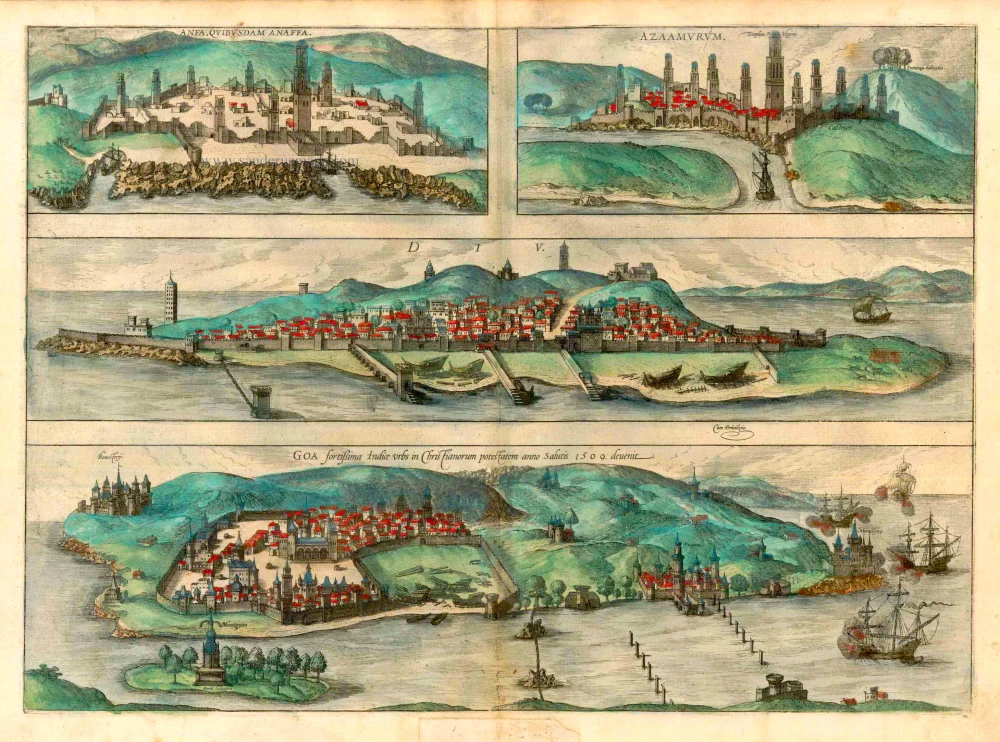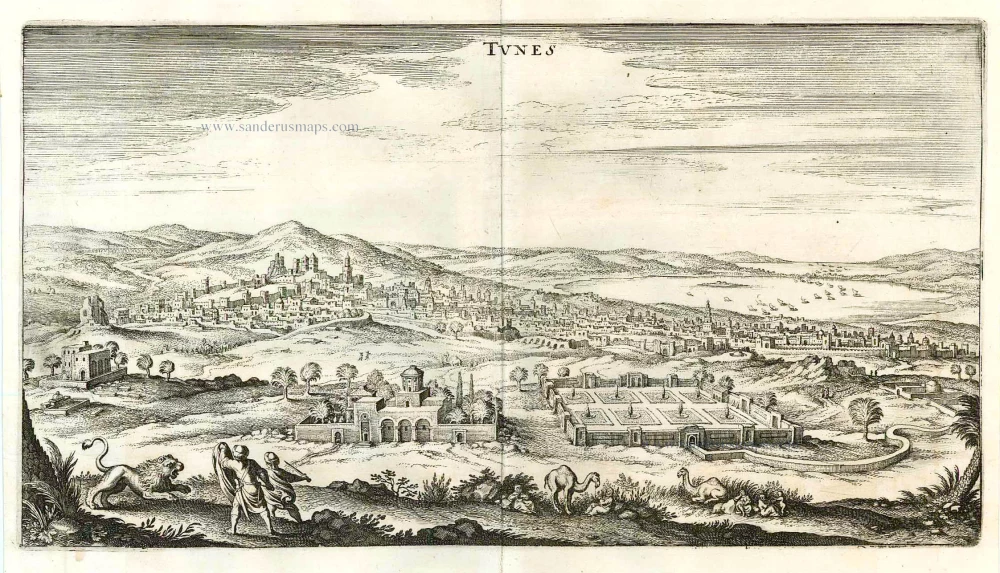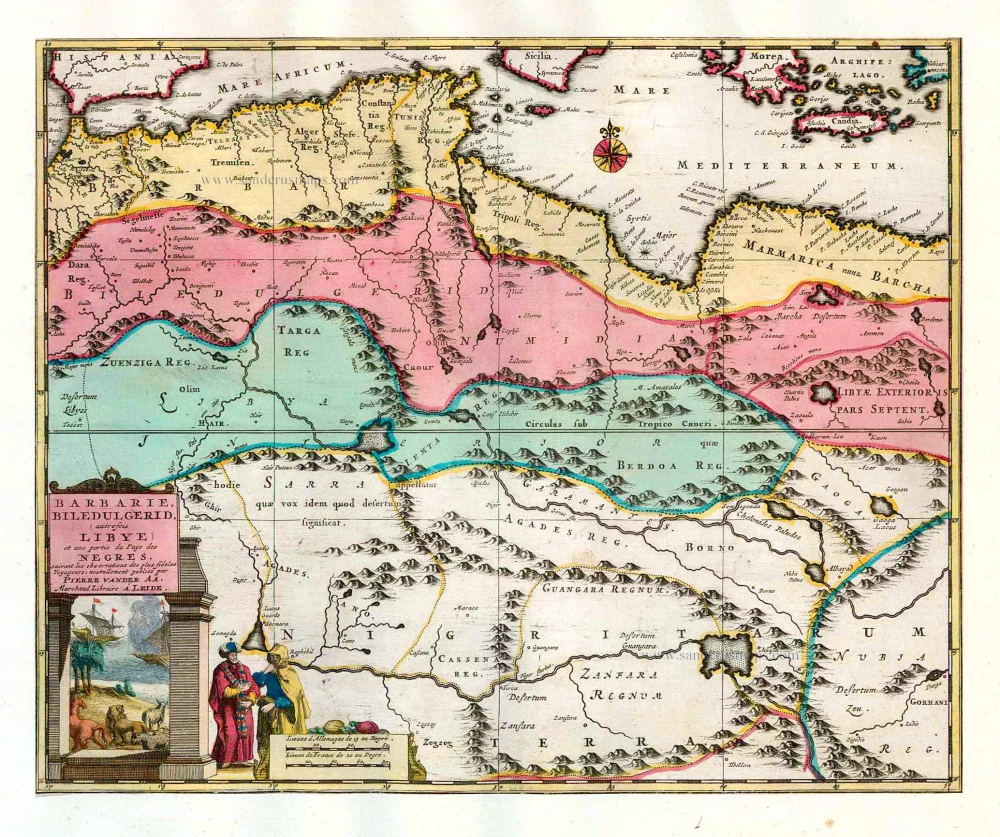Old, antique map of Tunis, Mahdia & Penon de Veles by Braun & Hogenberg 1593
Braun G. & Hogenberg F. and the Civitates Orbis Terrarum.
The Civitates Orbis Terrarum, also known as the 'Braun & Hogenberg', is a six-volume town atlas and the most excellent book of town views and plans ever published: 363 engravings, sometimes beautifully coloured. It was one of the best-selling works in the last quarter of the 16th century. Georg Braun, a skilled writer, wrote the text accompanying the plans and views on the verso. Many plates were engraved after the original drawings of a professional artist, Joris Hoefnagel (1542-1600). The first volume was published in Latin in 1572 and the sixth in 1617. Frans Hogenberg, a talented engraver, created the tables for volumes I through IV, and Simon van den Neuwel made those for volumes V and VI. Other contributors were cartographers Daniel Freese and Heinrich Rantzau, who provided valuable geographical information. Works by Jacob van Deventer, Sebastian Münster, and Johannes Stumpf were also used as references. Translations appeared in German and French, making the atlas accessible to a wider audience.
Since its original publication of volume 1 in 1572, the Civitates Orbis Terrarum has left an indelible mark on the history of cartography. The first volume was followed by seven more editions in 1575, 1577, 1582, 1588, 1593, 1599, and 1612. Vol.2, initially released in 1575, saw subsequent editions in 1597 and 1612. The subsequent volumes, each a treasure trove of historical insights, graced the world in 1581, 1588, 1593, 1599, and 1606. The German translation of the first volume, a testament to its widespread appeal, debuted in 1574, followed by the French edition in 1575.
Several printers were involved: Theodor Graminaeus, Heinrich von Aich, Gottfried von Kempen, Johannis Sinniger, Bertram Buchholtz, and Peter von Brachel, all of whom worked in Cologne.
Georg Braun (1541-1622)
Georg Braun, the author of the text accompanying the plans and views in the Civitates Orbis Terrarum, was born in Cologne in 1541. After his studies in Cologne, he entered the Jesuit Order as a novice, indicating his commitment to learning and intellectual pursuits. In 1561, he obtained his bachelor's degree; in 1562, he received his Magister Artium, further demonstrating his academic achievements. Although he left the Jesuit Order, he continued his studies in theology, gaining a licentiate in theology. His theological background likely influenced the content and tone of the text in the Civitates Orbis Terrarum, adding a unique perspective to the work.
Frans Hogenberg (1535-1590)
Frans Hogenberg was a Flemish and German painter, engraver, and mapmaker. He was born in Mechelen as the son of Nicolaas Hogenberg.
By the end of the 1560s, Frans Hogenberg was employed upon Abraham Ortelius's Theatrum Orbis Terrarum, published in 1570; he is named an engraver of numerous maps. In 1568, he was banned from Antwerp by the Duke of Alva and travelled to London, where he stayed a few years before emigrating to Cologne. He immediately embarked on his two most important works, the Civitates, published in 1572 and the Geschichtsblätter, which appeared in several series from 1569 until about 1587.
Thanks to large-scale projects like the Geschichtsblätter and the Civitates, Hogenberg's social circumstances improved with each passing year. He died as a wealthy man in Cologne in 1590.
Tunes Oppidum Barbarie & Regina fedes 1535 ... [on sheet with] Africa olim Aphrodisum [and] Penon de Veles
Item Number: 21452 Authenticity Guarantee
Category: Antique maps > Africa
Old, antique map with three bird's-eye views: Tunis, Mahdia and Penon de Veles.
TUNIS
TRANSLATION OF CARTOUCHE TEXT: Tunis, town of the Berbers and royal seat, drawn true to life in 1535 by Johannes Maius, His Majesty's court painter, following its capture by Emperor Charles V.
COMMENTARY BY BRAUN: "There are many clothe weavers in this town, for the women normally do nothing else but spin very fine and delicate thread, the cloth made from this is traded all over Africa and fetches high prices. ... There is no river, no spring or sea; thus the inhabitants make use of rainwater, which they collect in cisterns. Only on the outskirts of town is there a saltwater spring, out of which numerous carriers bring the water into town to sell. Otherwise there is also a freshwater lake, but this is reserved for the princes and courtiers."
MAHDIA (AL-MAHDIYA)
CAPTION: Africa, once called Aphrodisium.
COMMENTARY BY BRAUN: "Aphrodisium, which is now commonly called Africa, but by the Moors Mahdia, lies in the sea ... The acces from land is so formidably fortified with immense towers, labyrinthine walls and outfitted with tower galleries and hideouts that it stretches the powers of the imagination. Hence the Moors considered it unassailable.'
The bird's-eye view depicts the Peninsula of Mahdia, Aphrodisium or Africa in the throes of deadly battle on the water and on land. In 1546 the pirate Turgut Reis, following the death of Admiral Khair ad-Din, called Barbarossa, became the new commander-in-chief of the Ottoman naval forces. He besieged and plundered such places as Sicily and Calabria and attacked the Spanish bases in North Africa. In 1549 he captured the town of Mahdia, supremely protected by defensive labyrinthine walls. The plate depicts the massive recapture at sea and on land by the Spanish Admiral Andrea Doria and the Maltese Claude de la Sengle in September 1550. Mahdia, or the Horn of Africa, is located on an ancient site, which in the 16th century was thought to be Ptolemy's Aphrodisium.
PEÑON DE VÉLEZ DE LA GOMERA
COMMENTARY BY BRAUN: "Peñon de Vélez is a very old town on the shore of the Mediterranean; it was called Velles de Gumenera or Pennon de Velles by the Spaniards and more than 600 families reside there. It is located between two high mountains. Fresh water is a rare commodity for them since they must all use a watering hole located on the outskirts of town. The citizens are divided into two groups: many of them are fishermen, the others are pirates, who brings the Christians great misfortune."
The plate depicts a small rocky island under siege cannon fire from the land as well as from the sea. Fortifications with towers, walls and planted flags can be identified on the sheer cliffs of the island. The Spanish, battling the resident pirates there, initially captured the island in 1508. Afterwards it fell under Moroccan rule for 42 years until the Spanish won it back 1564. Because the island was occupied constantly and difficult to hold, it was allegedly blown up in 1871. (Taschen)
The view is made after an engraving by Giovanni Francesco Camocio, c. 1570.
Date of the first edition: 1575
Date of this map: 1593
Copper engraving
Size: 33 x 47cm (12.9 x 18.3 inches)
Verso text: Latin
Condition: Old coloured, small repair at centrefold.
Condition Rating: A
References: Van der Krogt 4, 4516; Taschen, Braun and Hogenberg, p.198.
From: Civitates Orbis Terrarum, ... Part 2: De Praecipuis, Totius Universi Urbibus, Liber Secundus. Köln, Gottfried von Kempen, 1593. (Van der Krogt 4, 41:1.2)
Braun G. & Hogenberg F. and the Civitates Orbis Terrarum.
The Civitates Orbis Terrarum, also known as the 'Braun & Hogenberg', is a six-volume town atlas and the most excellent book of town views and plans ever published: 363 engravings, sometimes beautifully coloured. It was one of the best-selling works in the last quarter of the 16th century. Georg Braun, a skilled writer, wrote the text accompanying the plans and views on the verso. Many plates were engraved after the original drawings of a professional artist, Joris Hoefnagel (1542-1600). The first volume was published in Latin in 1572 and the sixth in 1617. Frans Hogenberg, a talented engraver, created the tables for volumes I through IV, and Simon van den Neuwel made those for volumes V and VI. Other contributors were cartographers Daniel Freese and Heinrich Rantzau, who provided valuable geographical information. Works by Jacob van Deventer, Sebastian Münster, and Johannes Stumpf were also used as references. Translations appeared in German and French, making the atlas accessible to a wider audience.
Since its original publication of volume 1 in 1572, the Civitates Orbis Terrarum has left an indelible mark on the history of cartography. The first volume was followed by seven more editions in 1575, 1577, 1582, 1588, 1593, 1599, and 1612. Vol.2, initially released in 1575, saw subsequent editions in 1597 and 1612. The subsequent volumes, each a treasure trove of historical insights, graced the world in 1581, 1588, 1593, 1599, and 1606. The German translation of the first volume, a testament to its widespread appeal, debuted in 1574, followed by the French edition in 1575.
Several printers were involved: Theodor Graminaeus, Heinrich von Aich, Gottfried von Kempen, Johannis Sinniger, Bertram Buchholtz, and Peter von Brachel, all of whom worked in Cologne.
Georg Braun (1541-1622)
Georg Braun, the author of the text accompanying the plans and views in the Civitates Orbis Terrarum, was born in Cologne in 1541. After his studies in Cologne, he entered the Jesuit Order as a novice, indicating his commitment to learning and intellectual pursuits. In 1561, he obtained his bachelor's degree; in 1562, he received his Magister Artium, further demonstrating his academic achievements. Although he left the Jesuit Order, he continued his studies in theology, gaining a licentiate in theology. His theological background likely influenced the content and tone of the text in the Civitates Orbis Terrarum, adding a unique perspective to the work.
Frans Hogenberg (1535-1590)
Frans Hogenberg was a Flemish and German painter, engraver, and mapmaker. He was born in Mechelen as the son of Nicolaas Hogenberg.
By the end of the 1560s, Frans Hogenberg was employed upon Abraham Ortelius's Theatrum Orbis Terrarum, published in 1570; he is named an engraver of numerous maps. In 1568, he was banned from Antwerp by the Duke of Alva and travelled to London, where he stayed a few years before emigrating to Cologne. He immediately embarked on his two most important works, the Civitates, published in 1572 and the Geschichtsblätter, which appeared in several series from 1569 until about 1587.
Thanks to large-scale projects like the Geschichtsblätter and the Civitates, Hogenberg's social circumstances improved with each passing year. He died as a wealthy man in Cologne in 1590.

